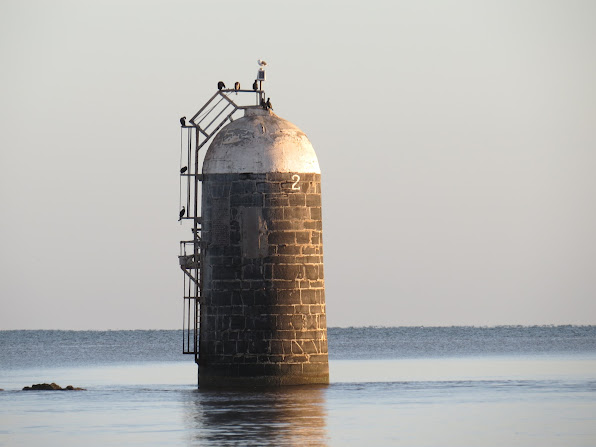Aleria lighthouse, the River Boyne
The Aleria lighthouse (above) is not one of your classical lighthouses, tall and slender, tapering slightly as it rises, perched on a jutting headland. It sits at the eastern end of a rubble breakwater, marking the northern point of the River Boyne where it flows out into the sea, guiding vessels into the estuary and then upriver seven kilometers to the port of Drogheda. The light is situated on top of a solid, ten-meter-tall, unpainted stone tower and a white stone dome. It is accessed by an external ladder and flashes green to make sure ships entering the Boyne keep it to starboard. Its nearest relations in the lighthouse world would be the Muglins (off Dalkey, county Dublin) and Ballagh Rocks (in county Donegal.)
The River Boyne marks the boundary between counties Louth (to the north) and Meath (to the south) As such Aleria is in county Louth but the best views of it are from Mornington, co. Meath on the south bank of the Boyne. The rubblestone jetty is quite long and fairly untraversable and mostly submerged, plus there's a lot of hiking to be done. The south bank of the Boyne, with its three stilted lighthouses and the Maiden Tower is far more interesting anyway.
The lighthouse was first established in 1936 though its origins go back over 80 years prior to this. The Boyne, like the whole east coast of Ireland, had a problem with shifting, drifting sands blocking up its entrance and forming a bar of shallower water across its entrance. Just as they did in Dublin, parallel walls were erected from the northern and southern entrances of the river 300 meters into the Irish Sea to stop the estuary silting up. This took place in the 1850s and a wooden perch was placed at the end of each bull wall, roughly 200 meters apart (eOceanics puts the distance at a mere fifty meters)
Aleria and the South Perch today
Something must have happened to that original wooden perch at the end of the north bull wall. It was still there in 1864, when the Ballast Board did a navigational survey of Ireland's harbours. Not only was the perch there but there was also a fog bell, which was sounded during foggy weather when steamers were expected. However, in 1867, it was reported that "the new red buoy" was being removed from the end of the wall and the North perch had been brought into position by a tugboat. Maybe it had just been moved temporarily while the wall was strengthened.
Again, it seems that the wooden perch transformed into a stone perch before the end of the century, with a flat top, apparently to take a light on top at some future date. This never happened and around the start of the 1900s the rounded dome was added, but with an square aperture in the west side, again to take a light at some future date.
In 1907, the wooden perch on the south side of the channel was washed away and was replaced by a black can buoy.
In 1917, Chadwicks of South Castle Street, Liverpool were commissioned to make a lamp for the North perch. It would light for four days on the trot and showed a brilliant light that 'could be seen at Laytown Railway station,' a statement which makes one worry for the sanity of the Harbour Board.
A letter from one Denis Lyons of "The Anchorage, Mornington" in the Drogheda Independent of 28th December 1935 indicates that things have been allowed to slide.
"The North Wall would not take much to finish out to Aleria," he says, insinuating that parts of it had been washed away. "The stones are already there."
"... how primitive are our fog signals. All we have is a hand sounded bell rung in fog by a man in a boat," implying the North Perch fog bell was a thing of the past. He also mentioned that the square aperture had been sealed up.
Stung into action - or maybe it was sheer coincidence - the Harbourmaster reported in June 1936 that he hoped to have the aperture cut out of the Aliara (sic) beacon by the end of the week to take the Aga light. It was presumably on the fitting of the lamp that Aleria was enrolled into the Wonderful World of Lighthouses club, having come up through the ranks.
Finally in 1954, we get a remarkable statement from the Harbour Board regarding Aleria. They were contemplating altering the light on Aleria so that it would show to ships entering the Boyne, as well as those leaving it. Hitherto, ships would have been entering the narrow channel blind, except for those travelling via Laytown Train Station. Well, not quite blind. The wonderful lighthouses on stilts on the south shore would have been visible, I suppose.
Under consideration was whether an outward-looking light - probably acetylene like the one on the inward side - could be incorporated into the dome of the tower, as waves often crashed over the top of it.
The beacon at the end of the South Perch today
Evidently, they figured it out eventually, as a quick-flashing green light now shows from the top of the dome. It is currently powered, like most coastal lights, by LED. The close-up photographs above also show the blocked up square aperture in the brickwork of the tower.
For anyone planning to go lighthouse bagging at Mornington, its a wonderful place to tick off several very interesting lighthouses and daymarks on the south side of the Boyne estuary.
Drogheda West lighthouse (1842)
Distinctive stone beacons on the north side of the river from which lamps would be slung nightly (1850s?)
The Lady's Finger (aka The Thumb) behind the Maiden Tower (c.1570?) two daymarks built to guide ships over the bar
Drogheda North lighthouse (1842)
Drogheda East light (1842)















Comments
Post a Comment